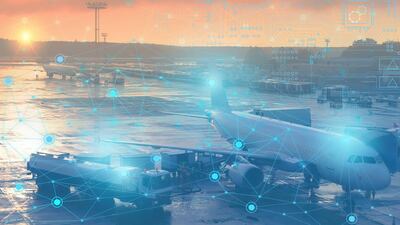With internet speed of up to 10 gigabits per second — more than 100 times faster than its predecessors — the fifth-generation (5G) wireless network will be a game-changer for the aviation sector, industry experts predict. The size of 5G market in global aviation industry is estimated to grow to $4.2 billion (Dh15.4bn) by 2026, up from just $200 million last year, according to aviation technology group Sita, based in Switzerland. Growing demand for a better flight experience, greater use of connected devices and the need for fast internet connectivity at airports and on board aircraft are all expected to drive demand. The National looks at how 5G will disrupt the aviation industry in the coming years.
What is driving demand?
The growth in air passenger traffic and travellers spending a lot of time at airports will propel the adoption of 5G by airports and flight operators. Passengers usually spend an average of three hours at airports and this can go as high as four hours when they have connecting flights, according to a survey by Dufry, a Swiss travel retailer. The lack of availability of strong internet connectivity is a common complaint among travellers, but the high speed and long-range capabilities of 5G are expected to address this issue.
What about the costs?
The cost of 5G is high as operators need to change their entire infrastructure. For example, 4G connectivity is provided through a low-band spectrum ranging between 5 megahertz to 10MHz. Whereas a 5G network requires spectrum bands with a width greater than 200MHz. The level of investment required for this roll-out is one of the major challenges of 5G adoption in aviation, according to a report syndicated by Markets and Markets. In an analysis of one European country, consultancy McKinsey predicted that network-related capital expenditure for 5G would have to increase 60 per cent from 2020 to 2025, roughly doubling total cost of ownership to a network operator during that period. These costs are likely to be passed on to consumers.
How will 5G improve airport connectivity?
Currently, 4G technology can manage abpit 10,000 devices in each square kilometre but a 5G network can manage a million. A widespread adoption of the Internet of Things, connecting hundreds of devices at airports, brings about the inherent need to adopt 5G. “We are already using 4G for IoT applications used in biometric passenger processing such as smart path and baggage management, and the uptake of 5G will provide many more opportunities,” said Gilles Bloch-Morhange, vice president of Sita. “5G is already enhancing our existing applications at airports … communications, operations, baggage management and passenger processing.”
What problems can 5G solve at airports?
Artificial intelligence-backed technology will solve major pain points, according to Sita. For example, biometrically matching passengers to their bags will be simple. AI-assisted computer vision will continually scan boarding gate areas and predict capacity issues for hand luggage on flights, enabling staff to plan accordingly before boarding.
And how will it help airline operators?
5G will allow next-generation aircraft to exchange vast amounts of data around the airport and at the gate. “The fast transmission and the timely analysis of aircraft data will enable pro-active maintenance, quicker aircraft turn-around, more on-time departures and an improved customer experience,” said Sita.


